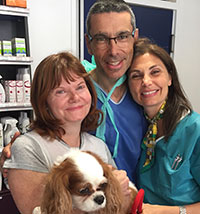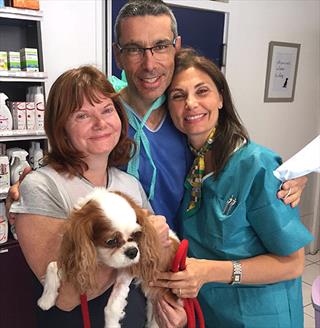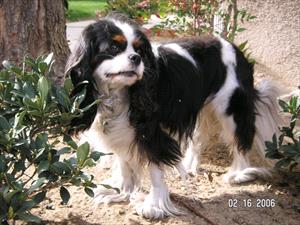

Photo by Jerry M. Thornton
On the day of her dog Harper’s discharge following successful open-heart surgery, Kim Campbell Thornton celebrates with Drs. Jean-Hugues Bozon and Sabine Bozon, owners of one of the three veterinary hospitals in the world that offer mitral valve repair surgery regularly.
When you’ve watched one dog die from congestive heart failure, you don’t want to repeat the experience. So when your dog is given a death sentence due to heart disease, you look for a way out. For my husband and me, the way out was to take our sick dog, Harper, from our home in California to Versailles, France, for a surgical reprieve.
Harper, a cavalier King Charles spaniel, was diagnosed in January with congestive heart failure from inherited degenerative mitral valve disease. She is 9 years old. Our journey to save her began before she was born — it started 11 years ago, when we lost Darcy, also a cavalier, to the same condition. Darcy was 6½.
I remember frantically trying to find a way to save her. Surely there was some kind of surgery? As a journalist who writes about companion animals, I had access to the best veterinary cardiologists in the country. No one knew of anything that could help. Mitral valve repair surgery is widely available for people but not for veterinary patients.
Darcy was the first puppy my husband and I had owned. Other dogs we had acquired as adults. We loved them all deeply, but I think there is something special about a dog you bring up from puppyhood. And Darcy was a special puppy, indeed. She loved everyone. She was wicked smart. She had beautiful manners, except for her need to kiss everyone she met.
Like every cavalier owner, I worried that mine would develop mitral valve disease. MVD is the leading cause of death of cavaliers in the world, according to cavalierhealth.org, which is run by the nonprofit Cavalier Health Fund. The group reports that MVD has been found to be 20 times as prevalent in cavaliers as the average of other breeds.
The mitral valve is one of four heart valves that keep blood moving in the proper direction. Healthy valves open and close in coordination with the heart’s pumping action. Faulty valves can impede sufficient blood flow or let blood leak in the wrong direction, a problem known as regurgitation.
Darcy was 3 when, at a health fair where cavaliers could receive a low-cost stethoscope examination by a specialist, a cardiologist turned to me with a concerned look. “She’s not a breeding dog, is she?” she asked.
The doctor said Darcy had a grade-three murmur (on a scale of one to six), meaning it was moderately loud and likely related to structural heart disease — in this case, a degenerating mitral valve.
That was OK. I was sure Darcy would remain asymptomatic like our older cavalier Bella. For a couple of years, she did. But then the disease progressed hard and fast. With congestive heart failure, a patient has difficulty catching her breath as fluid builds up in the lungs. Watching the fear on Darcy’s face as she struggled to breathe was heartbreaking.
Darcy took several medications, including pimobendan (Vetmedin). They helped for a little while, but she was dead seven months after beginning treatment.
We mourned for a long time. We founded the Darcy Fund to support MVD research. We raised several thousand dollars, which was routed through the Charitable Trust of the American Cavalier King Charles Spaniel Club.
Happily, our other two cavaliers were examples of dogs who can live with the disease for years with little problem. About 18 months after Darcy died, we were ready for another puppy. Bella was 12, and I wanted to make sure she was around to train the new puppy the way she had Darcy.
Harper attached herself to me from the time we brought her home at 11 weeks of age. She’s our solid-gold travel buddy, a veteran of trips to San Francisco, Santa Fe, Jackson Hole, Seattle, Vancouver and more. For the past three years, she and I have been competing and excelling in nose work trials, in which she finds and indicates specific odors in various locations and environments.
At age 5, Harper was diagnosed with a heart murmur but was asymptomatic.
When she was 6, I read an article about a man who raised $32,000 to fly a Japanese veterinary surgeon, Dr. Masami Uechi, to Cornell University in Ithaca, New York, to perform mitral valve repair surgery on his Japanese chin, Esme. Uechi developed the open-heart procedure to improve valve function and replace the chordae tendineae — which hold the valve in proper position — in affected dogs. I was greatly interested in learning more and filed it away in my head as something to look into, but at the time, I was unable to contact Esme’s owner or find out much about the procedure.
Last November, I stumbled across information about a Facebook page for people who were seeking information about the surgery. At that point, the surgery still was of academic interest only to me. I hoped that Harper and our other cavalier, Keeper, would be like our cavaliers Bella and Twyla, who had lived to the respectable ages of 15 years and 12 years.
But in January, Harper, now 9, started coughing. She had been eating grass at a nose work trial a few days before, so at first I chalked it up to that. Then we noticed that she seemed restless and her respiratory rate was higher than normal.
We knew what that meant. The signs were mild enough that the ER veterinarian — because these things always happen on weekend nights — just sent her home after taking chest X-rays and telling us what we already knew: Her heart was enlarged. Harper’s cardiologist, Dr. Sarah Miller, reviewed the X-rays the next day and started Harper on medication.
I asked Miller if she was familiar with “that surgery” and if she thought Harper would be a good candidate. Other than her heart condition, Harper was in great shape with an adventurous, young-at-heart spirit. I wasn’t going to let her go down without a fight.
Somewhat to my surprise, Miller did know about the surgery. Her husband, also a veterinary cardiologist, had a client who had taken her dog to France for the procedure and was pleased with the results. Because I had already spoken extensively with two people whose dogs had had the surgery, and I had a second opinion from a respected cardiologist I knew, my husband and I were able to make a quick decision. We both wanted to do whatever it took to give Harper a chance.
I asked Miller to move forward with finding out more. After a battery of lab tests and diagnostics, we received an email on March 7 saying that Harper was scheduled to undergo surgery on May 26. We made flight reservations, got the required vaccinations and microchipping for entry into France under way, and found an Airbnb home in Versailles that welcomed Harper.
Ours was one of four families scheduled in May. Through the Facebook page, we avidly followed the progress of the dogs who underwent surgery in March. (Surgeries in France take place one week every other month; the clinic is booked through January). We all mourned when one man’s dog died just days before their flight to France, and we held our breath when another patient was slow to awaken after surgery. Once in France, we and the other couples became fast friends, sharing meals and offering support to whomever had a dog in surgery each day.
Harper was scheduled on a Friday, the last surgery of the week. I worried. Would the surgical team be in the Zone, having already completed four successful surgeries? Or would they be tired, prone to mistakes? The night before, Harper slept in the crook of my knees like always. I hoped it wasn’t for the last time.
The surgery usually takes 7½ hours; with complications, it can go as long as 15 hours. The procedure is described here. In simple terms, while the dog’s heart is stopped, and life-support provided through a cardiopulmonary bypass machine, the surgeon rebuilds the deformed mitral valve, using a ring made of a plastic called expanded polytetrafluoroethylene to improve the orifice. He also uses ePTFE to replace the cords that hold the valve leaflets, or flaps, in place. We like to joke that Harper got a ring and valve job.
As of May, Uechi had performed the procedure on approximately 700 dogs. He offers it two days a week at his Japan Animal Specialty Medical Institute Veterinary Cardiovascular Medical Center in Yokohama; on a bimonthly basis at the Clinique Veterinaire Bozon in Versailles; and occasionally at the Animal Recovery Veterinary Referral Centre in Singapore. The success rate is 90 percent. Variables include a dog’s age, heart status and overall health.
Harper’s surgery was a success. Her heart is back to normal size, and the regurgitation also is at normal levels. Her recent one-month checkup showed a small blood clot in the pulmonary vein, so she's back on heparin but Dr. Sabine Bozon, the veterinarian who managed Harper’s case in France, expects the clot to dissolve in two to four weeks.
You probably want to know how much something like this costs. It’s expensive. There’s no getting around that. I’m a freelance writer and my husband is an information technology consultant. We’re not poor, but we don’t have $50,000 lying around. The cost of the surgery in France is $40,000, which includes flying in the Japanese surgical team. The preliminary testing, two post-surgical exams after the dog goes home, and travel expenses add up to $10,000 more.
Taking a dog to Japan for surgery is approximately half the cost of going to France but involves a seven-month waiting period to meet quarantine requirements. When we planned Harper's treatment, we weren’t sure she had that much time.
Darcy 2006

Photo by Jerry M. Thornton
Darcy was 6½ when she died of congestive heart failure. Love and sorrow over her difficult death motivated the author and her husband to travel nearly halfway around the world in a quest to save Harper from a similar end.
What possesses someone to spend that kind of money on a pet? To me, it’s no different from spending on a luxury car or a beautiful piece of art.
I love fast sport cars. Probably no one would bat an eye if I were to drop $50,000 on a BMW Z4 with a six-speed stick shift. Nor would it seem unusual to most observers if I were to put that amount to a Sprinter van to drive to nose work trials and haul my standup paddleboard.
Spending that sum to buy more time with a family member we love, who is special to us, who is a talented partner in a fun sport, seems worthwhile. As the 18th century English author Samuel Johnson said, “No money is better spent than what is laid out for domestic satisfaction.”
We financed the surgery with a home equity line of credit. When we explained how we’d be using the money, the loan consultant said simply, “We’re going to make sure you can help your dog.” He called to see how the surgery had gone and when we told him the results, he said, “You just made my day.”
Pet health insurance generally covers the cost of preliminary lab work and diagnostics and post-surgical exams, but only two insurance companies have said they would cover surgery performed overseas. Even then, the payout would not cover all the costs. Dr. Sabine advises her clients with cavalier puppies to start saving right away in case their dog needs surgical repair one day.
In any case, we didn’t have pet health insurance. At the time we acquired Harper, we knew nothing about the possibility of repair surgery, and pet health insurance at the time often didn’t cover cavaliers for heart-related issues. There are better options these days, though, so we’ll definitely cover a future dog.
For now, our 12-year-old Subaru Outback and 17-year-old Mazda Miata will have to keep running, I took a part-time job, and we likely won’t be making the trip to Patagonia that we’d been planning. Our dining-out expenses have plummeted, I don’t bother going clothes shopping, and I’m buying many fewer books for my Kindle — at least until I read all the ones already on it.
Am I still committed to cavaliers? I was asked that after Darcy died. After a long pause, my answer then was yes, and it still is. Every breed has issues. Having faced both cancer and MVD in dogs (our greyhound had bone cancer), I think I would rather deal with MVD. I do consider other breeds or mixes. Our teenage Chihuameranian may outlive us all. But cavaliers are a good fit for us in size and personality so, yes, I probably will have another one at some point.
Mitral valve repair surgery won’t be available in the United States any time soon, but Dr. Simon Swift, medical director of the small animal hospital at the University of Florida's College of Veterinary Medicine, tells me UF has a three-year plan to make it available. The Mighty Hearts Project, founded by owners of dogs who have benefited from the surgery, is working to raise awareness around the country of the procedure.
Surgeons at other universities are attempting mitral valve replacement surgery rather than repair, or repair using other devices or techniques, but so far, no one has a successful track record. Until surgeons in North America learn and become experienced at Uechi’s technique, build a strong surgical team and acquire the necessary equipment, all of which requires a heavy investment of time and money, the expense likely will remain high here for the foreseeable future.
Mitral valve repair surgery isn’t the right choice for everyone, but for young or middle-age dogs whose owners can foot the bill without putting themselves in financial distress, it’s an option to consider. We're glad we did. Harper now has the prospect of living a normal cavalier lifespan of 15 years or more.
About the author: Kim Campbell Thornton has been writing about dogs and cats for 31 years and has won multiple awards for her books and articles. Her muses are two cavaliers and a Chihuahua-Pomeranian mix. Kim lives in Southern California.